SEO stands for Search Engine Optimisation, and is intended to get your website in front of more users and increase your web traffic. This is done primarily through improving rankings in search engines for your most important keyword terms.
It also works together with PR and other marketing activities to drive traffic to your site, but for this blog we’ll stick with the more traditional definition.
How does it work?
By improving different aspects of your site, you are deemed more relevant for certain terms – giving higher rankings for different terms. For example, the number 1 position for the search terms ‘shoes’ is considered the most relevant for that search.
There are differences results depending on your search engine, search history, location, language, etc. Hundreds of ranking factors are taken into account as well. These are then combined to give you the best results.
Why is it important?
With trillions of searches happening every day, you want to make sure that you are at what people see when they are searching online.
The number 1 position on SERPs is so coveted because it gains the vast majority of clicks. The graph below shows the click-through-rate for organic results, and we can clearly see the importance of position 1.
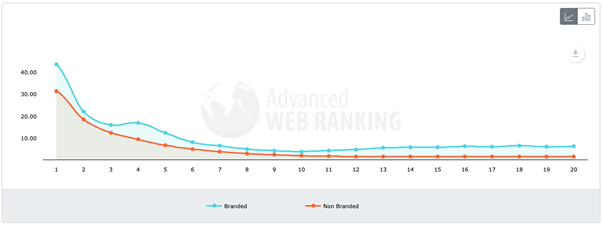
By page 2, the click-through-rate is down to just 2-3%. There is still traffic to be gained here, but ultimately you want to improve your SEO to get you to the higher positions and then gain increased traffic.
Statistics over recent years show how much is spent online. The graph below shows how many billions of pounds have been spent online over recent years.
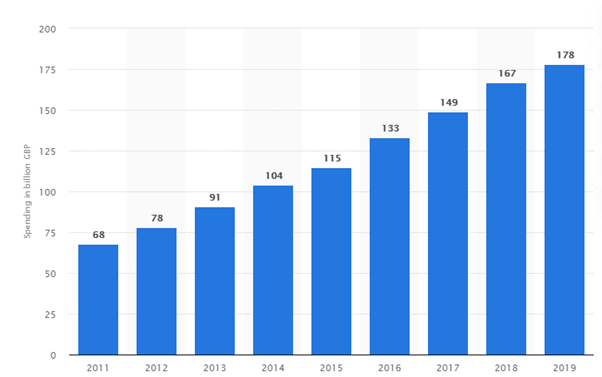
Source – https://www.statista.com/statistics/285374/online-retail-spending-in-the-united-kingdom-uk/
Although 2020 data isn’t compiled yet, we already know that it will be another record-breaking year, particularly due to lockdowns and a further switch from in-person shopping to online.
Looking at just the UK again, we saw a huge shift towards online shopping, with nearly a third of all retail purchases being made online in May 2020.
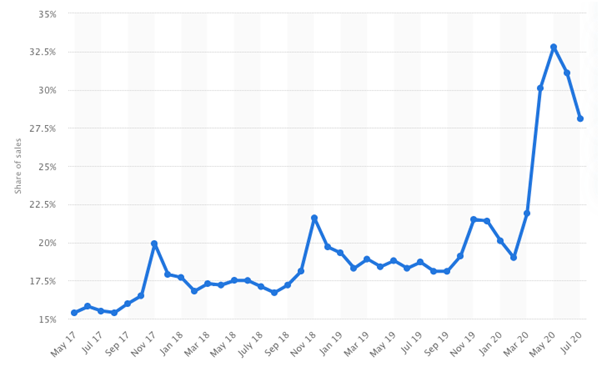
Source – https://www.smartinsights.com/digital-marketing-strategy/online-retail-sales-growth/
SERPs Explained
Here is a screenshot of a typical results page:
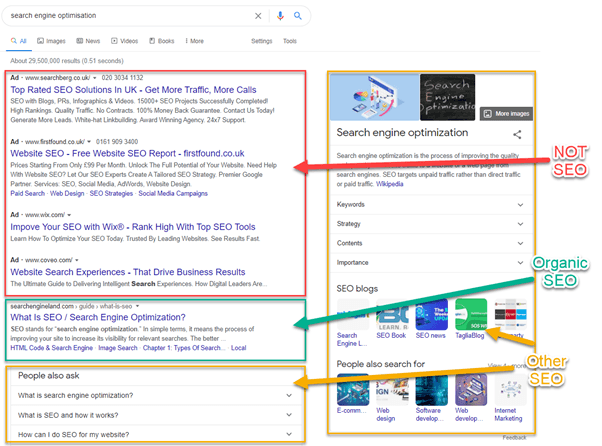
We can see a large portion of the screen is taken up by paid listings, and there are numerous ‘other’ listings – which are related to SEO, but we’ll come back to this later.
N.B: ‘Other SEO’ Isn’t a widely used term, I’ve just put it here to show that these aren’t primary/organic search results.
The main point is the section marked ‘Organic SEO’, which is the coveted number 1 spot. You’ll see the term ‘organic’ a lot in terms of SEO, and it basically means the main results listings which aren’t paid for.
This is what a search engine (Google.co.uk in this case) think is the most important result, and therefore the most worthy of your click, giving you the best user experience.
The rest of the page will list the remaining organic search results and probably some further sections at the bottom of the page. These could include further paid results, related searches etc.
SEO explained
SEO is a diverse topic, and it has blurred edges as mentioned previously. For now we’ll stick to some of the most common factors that affect your SEO rankings. So, what factors are important to SEO?
Page Content
This is the most important factor from a user perspective, and arguably the most important from an SEO perspective.
The content of a page dictates what the page will be found for. It should be informative and help users in their search. This can be in the form of answers to questions in blog pages (like this), information about products as people search for specific items, or anything ese that you want to find online.
The more a page answers the question (search term), the better it will perform in rankings. This also reflects how general or niche a page is, with more tailored content reaching a smaller audience, but with a much better chance at that number 1 position.
Title Tag
Title tags are the name of the page. You might not see them on every page you visit, as they are often obscured in your browser – but you will see them in search engine rankings.
This is what it looks like in search results:

And how you can see it in a browser:
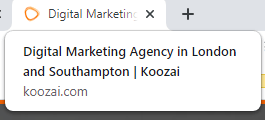
As this is what the page is about, it is a huge ranking factor and one of the main adjustments made to further your SEO.
Meta Description
Shown just below your title tag in search results, the meta description is a brief description of what you expect to find on the page.

Although these don’t have a direct affect on rankings, making a relevant and captivating meta description can be the deciding factor on a click.
As you can see above, when a keyword is present in a meta description you get the benefit of bold text in some search engines, helping draw the eye and give a better click-through-rate.
URL
The URL of a webpage is important for the structure of a site and also gives a further instance of keywords for a page.
Going back to the imaginary shoe shop for example, a product would be much better off on a well formed URL which explains to the user and web crawlers what the page is about:
Good URL Example – www.reallyniceshoes.com/brown-shoes/fancy-brown-shoe
Rather than a URL which doesn’t give any indication of what the page is about:
Bad URL Example – www.reallyniceshoes.com/category-45/product-123
There are also a few points to be careful about when creating your URL structure. You should keep them alpha-numeric and you can ignore punctuation as this will result in strange looking URLs. Also, separate words with hyphens, not underscores.
H1 Tags
Similar to title tags, this is also the title of the page, but the title that users see.

This is the current H1 tag on the Koozai homepage. As you can see it is different to the title tag above, as it is aimed more at users.
You can tell when a site has “too much SEO” in mind when this title tag doesn’t strictly make sense. Again, the focus is to make pages for users first, but so that bots and crawlers can read them as well.
Below is an exaggerated (and fake) example of the Koozai homepage if it was over-optimised for the digital marketing agency London & Southampton terms:

This doesn’t look good and to a user it doesn’t really make much sense, or help you understand what the page is about. This is an easy trap to fall into, so remember to write for users first.
Keywords in the page copy
If you are writing about a certain topic, the chances are pretty high that you will mention said topic a few times in your copy.
This seems fairly obvious, but even on a fundamental level sites can still get this wrong.
This will be linked to keyword research as well, so if it turns out a lot of people are looking for looking for product reviews, you can include ‘review’ related keywords. Similarly, if you want to target a certain type of product, then you can include the words – whatever they may be.
Internal Links
This often isn’t as though about as it should be, but you need to make sure that users and bots can navigate your site to get to all of your pages.
Bots will predominantly use sitemaps to navigate, but they will also follow on page links. Users will rarely use sitemaps, so you need to be sure that they can get to the right pages – either through menus, on-page linking or good search functions.
Linking internally gives signals about how important you think certain content or pages are. Your main pages should be in navigation and easily accessible from numerous pages. If you have a page which is deep in your site with few links pointing to it, the chances are this will not be ranked highly.
This is also related to your site structure, URLs and hierarchy, so make sure that this is considered during site creation.
Backlinks
Once the quintessential element of SEO, backlinks sometimes get a bad rep nowadays. You could build link after link in the past and be as spammy as you wanted, but this is a very outdated practice.
Backlinks are still relevant to your SEO performance, but you have to be much more discerning when reaching out for links and link building. Quality over quantity is the order of the day.
A perfect backlink isn’t really a thing and there are lots of factors at play, but you should consider relevance, user experience and authority. With these factors in mind you can help drive referral traffic as well as helping bolster your search engine rankings.
Social Signals
This doesn’t mean that you have to tweet 20 times a day, or post updates on Facebook incessantly. It means that your social media should be legitimate and active with your users.
You’ll notice when you search for brands, you’ll see links to their social channels in the knowledge graph or elsewhere on the results page. This is increasingly important to add to the legitimacy of online company personas as it is all too easy to create a brand which doesn’t really exist in real life.
Make sure that your site links to your social channels, and that you submit them onto your Google My Business listing so that every thing is linked together.
User Experience
Site speed and mobile friendly
User experience (UX) covers a lot of different facets of your site, but ultimately it should give an intuitive and seamless experience for users. Easy right?
Well, not so easy when you have to take into account an array of factors:
- Site speeds
- Responsiveness across devices
- Integrations with payment gateways and other 3rd party tools
- Navigation
- Language (both in terms of readability and location targeting)
- Content structure (H tags, bullet points, etc)
This is a fairly small sample of factors which help with UX. Many websites adopt standards (such as hamburger menus on mobile, homepage links at the top left, etc.), but if we didn’t have these, websites could be very counterintuitive.
Do I need SEO?
Without using your brand name, search for your main service offering and see if you appear.
Depending on the complexity of your search term, your industry, current positioning, etc. you might not appear.
If you are a local only business, you probably aren’t going to outrank Amazon. Try putting in location terms to see where you are rather than considering the whole world.
Likewise, you need to have realistic expectations around what you can rank for. Going back to the ‘shoes’ example, a small ecommerce site probably won’t compete with the big names like Office, Deichmann & Schuh (what I currently see in positions 1-3). Instead, if you’re more specific on your search terms, you can compete.
The term ‘shoes’ returns 5,130,000,000 results for me (Feb ’21), but the term ‘brown leather men’s shoes’ returns 117,000,000 results and quite frankly only around 20 pages of these are useful.
This reduction down to around 2% of the original term gives you a much greater chance to compete. Combined with these stats with brand terms and less competitive industries and you can have success at getting to number 1.
That being said, the answer is probably yes. It’s rare for a site to reach all of it’s potential without professional help.
The future of SEO
The general consensus is that user experience and relevancy will be the most important things to get to the number 1 position. The latest algorithm updates from Google have focused on this, as well as improving latent semantic indexing:
“Latent semantic indexing is a concept that search engines like Google use to discover how a keyword and content work together to mean the same thing. It is based on a series of mathematical equations and can be quite complex to fully understand.”
Source – https://themanifest.com/digital-marketing/how-use-latent-semantic-indexing-keywords-boost-your-seo
As well as this, our top predictions include:
- Increased reliance on voice search
- Increased mobile shopping
- Augmented reality for previews and fitting
- Further use of structured data for integrations across sites
Of course, these are all separate topics in themselves, but it will be interesting to see what can help improve SEO next.







Leave a Reply